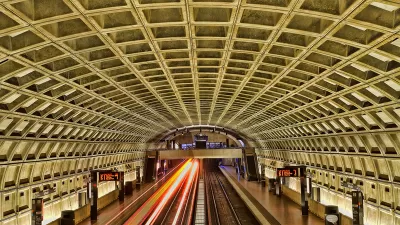The sharp historic division between commuter rail and other forms of transit has limited the ability of regional rail systems to serve more users.

Designed to serve suburban commuters, many of the country's regional rail systems don't provide efficient enough service to lure commuters out of their private vehicles, writes Jake Blumgart for Governing. "In recent decades, the vast web of rail lines that surround many older urban centers were only convenient if you worked a 9-to-5 job downtown." The stark division between "regular" transit and commuter rail in the minds of many transportation officials has left many workers with less traditional schedules without effective transit options.
"There are not such sharp contrasts between regional rail and the rest of transit systems in most wealthy European or East Asian nations. But in North America, the divide was sacrosanct. As recently as 2016, then-MBTA General Manager Frank DePaola drew a bright line between this service and the rest of the agency’s subway, bus, and light rail services: 'Commuter rail is commuter rail. It’s not transit. It’s designed to bring people into the city in the morning and take them home at night.'"
But the sharp drop in ridership during the last year has highlighted the problem with this mindset. After "commuter rail lines took a ridership hit of unprecedented magnitude," workers are slowly returning to their commutes, but "even those who go back to the office are anticipating that they will have more flexible scheduling and work-from-home opportunities a day or two a week." This means that "[i]f commuter systems try to return to their focus on white-collar suburban commuters, their ridership will be considerably thinned. To continue to attract riders and fares, they will need to change their appeal. To do that, they will need to change their frequencies and their fares."
FULL STORY: Taking the ‘Commuter’ Out of America’s Rail Systems

Alabama: Trump Terminates Settlements for Black Communities Harmed By Raw Sewage
Trump deemed the landmark civil rights agreement “illegal DEI and environmental justice policy.”

Planetizen Federal Action Tracker
A weekly monitor of how Trump’s orders and actions are impacting planners and planning in America.

The 120 Year Old Tiny Home Villages That Sheltered San Francisco’s Earthquake Refugees
More than a century ago, San Francisco mobilized to house thousands of residents displaced by the 1906 earthquake. Could their strategy offer a model for the present?

BLM To Rescind Public Lands Rule
The change will downgrade conservation, once again putting federal land at risk for mining and other extractive uses.

Indy Neighborhood Group Builds Temporary Multi-Use Path
Community members, aided in part by funding from the city, repurposed a vehicle lane to create a protected bike and pedestrian path for the summer season.

Congestion Pricing Drops Holland Tunnel Delays by 65 Percent
New York City’s contentious tolling program has yielded improved traffic and roughly $100 million in revenue for the MTA.
Urban Design for Planners 1: Software Tools
This six-course series explores essential urban design concepts using open source software and equips planners with the tools they need to participate fully in the urban design process.
Planning for Universal Design
Learn the tools for implementing Universal Design in planning regulations.
Clanton & Associates, Inc.
Jessamine County Fiscal Court
Institute for Housing and Urban Development Studies (IHS)
City of Grandview
Harvard GSD Executive Education
Toledo-Lucas County Plan Commissions
Salt Lake City
NYU Wagner Graduate School of Public Service





























